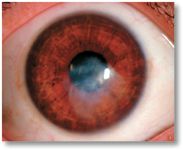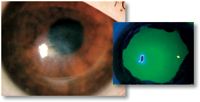Article
Femtosecond laser useful tool for corneal surgery
Dorado Beach, Puerto Rico—The IntraLase femtosecond laser (IntraLase Corp.) can be used to make visual rehabilitation faster and safer as well as for refractive procedures, according to Sonia H. Yoo, MD, at the Current Concepts in Ophthalmology meeting.

Because the femtosecond laser can be programmed to create flaps up to 400 µm thick, procedures such as anterior and possibly posterior lamellar keratoplasty and implantation of micro-thin prescription inserts (Intacs, Addition Technology) can be performed with good visual outcomes, explained Dr. Yoo, assistant professor of ophthalmology, Bascom Palmer Eye Institute, Miami.
When using the femtosecond laser, the side cut angle can be set as desired up to 90°. This allows a lamellar keratoplasty to be performed without placing sutures in the cornea, she said.

Case 1 described a 25-year-old man who had gradually worsening vision in his left eye over 3 years. Most recently, the patient's vision began to decline and glasses did not correct the problem. Examination revealed that his uncorrected visual acuity (UCVA) in the affected eye was 20/200+, and in the fellow eye it was 20/30. The IOP levels in the left and right eyes were 14 mm Hg and 12 mm Hg, respectively. The pupil in the left eye was 5 mm and reactive with no relative afferent pupillary defect.
At the slit lamp, a Fleischer ring was observed, according to Dr. Yoo. The corneal topography showed irregular and steep K readings with irregular astigmatism consistent with keratoconus. The right eye had –1.5 D spherical equivalent (–1.75 +0.75 × 15), and in the left eye –5.25 D spherical equivalent (–8.75 +7.00 × 70).
The treatment possibilities for this patient were glasses, contact lenses, or a number of surgical options that included lamellar keratoplasty, penetrating keratoplasty, epikeratophakia, implantation of micro-thin prescription inserts, implantation of a phakic IOL, or PRK/PTK.

Pachymetry was measured and the software was set for the corneal lamellar pocket dissection for the micro-thin prescription inserts. A bit of minor manual dissection was needed to start the pocket, according to Dr. Yoo.
Corneal scar develops Case 2 was that of a 41-year-old woman with a corneal scar in the visual axis of the right eye for 1 year that resulted from a Pseudomonas ulcer from contact lens use. The patient complained of poor-quality vision with blurring and glare.
Newsletter
Don’t miss out—get Ophthalmology Times updates on the latest clinical advancements and expert interviews, straight to your inbox.




